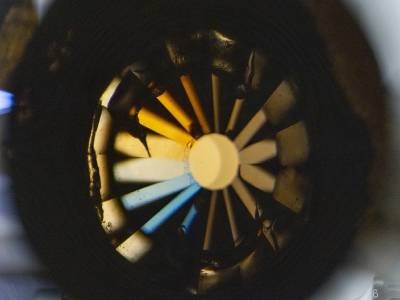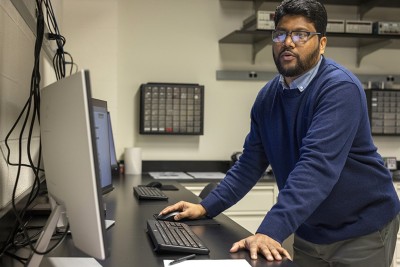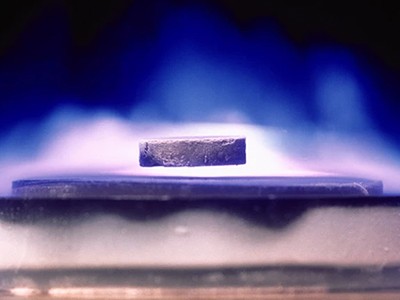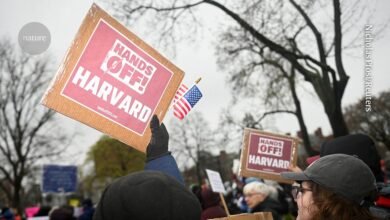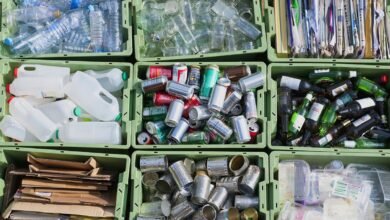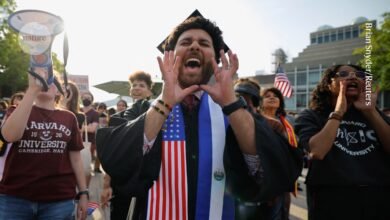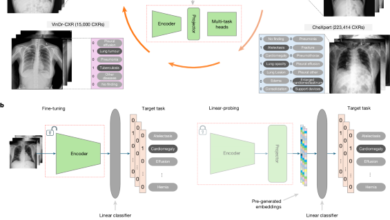
Ranga Dias, the physicist at the centre of the room-temperature superconductivity scandal, committed data fabrication, falsification and plagiarism, according to a investigation commissioned by his university. Nature’s news team discovered the bombshell investigation report in court documents.
The 10-month investigation, which concluded on 8 February, was carried out by an independent group of scientists recruited by the University of Rochester in New York. They examined 16 allegations against Dias and concluded that it was more likely than not that in each case, the physicist had committed scientific misconduct. The university is now attempting to fire Dias, who is a tenure-track faculty member at Rochester, before his contract expires at the end of the 2024–25 academic year.
Superconductivity scandal: the inside story of deception in a rising star’s physics lab
The investigation report (see Supplementary information) and numerous other documents came to light as the result of a lawsuit that Dias filed against the university in December last year. Dias submitted a grievance to Rochester over its decision to remove his students last August, but the university refused to hear the grievance on the grounds that it did “not relate to academic freedom”. The physicist’s lawsuit claims that this response was unreasonable. A university spokesperson declined to comment on the specifics of ongoing litigation and personnel matters, but emphasized that Rochester is “vigorously defending its course of action”.
In March, Nature’s news team uncovered details about how Dias distorted data to make claims about room-temperature superconductivity in two now-retracted papers published in Nature1,2, and how he manipulated his students to keep them in the dark about those data. (Nature’s news and journal teams are editorially independent.) Soon after, the Wall Street Journal reported that Rochester’s investigation found evidence of misconduct.
Now, Nature’s news team can reveal the details of that investigation. Documents filed by Rochester with the Monroe County Supreme Court show that the investigation was ordered by the National Science Foundation (NSF), a major funder of US academic research that in 2021 awarded Dias a prestigious US$790,000 CAREER grant. The NSF Office of Inspector General declined to comment to Nature’s news team on the investigation’s findings or the agency’s future actions.
The 124-page investigation report is a stunning account of Dias’s deceit across the two Nature papers, as well as two other now-retracted papers — one in Chemical Communications3 and one in Physical Review Letters (PRL)4. In the two Nature papers, Dias claimed to have discovered room-temperature superconductivity — zero electrical resistance at ambient temperatures — first in a compound made of carbon, sulfur and hydrogen (CSH)1 and then in a compound eventually found to be made of lutetium and hydrogen (LuH)2.
Capping years of allegations and analyses, the report methodically documents how Dias deliberately misled his co-authors, journal editors and the scientific community. A university spokesperson described the investigation as “a fair and thorough process,” which reached the correct conclusion.
Dias did not respond to requests for comment. His lawyer referred Nature’s news team to documents filed with the lawsuit. In one of those, Dias said: “It is imperative to reassert the foundational integrity and scientific validity of our work amidst the criticisms and accusations.”
A trio of inquiries
The NSF-ordered investigation wasn’t the first time Rochester examined possible problems in Dias’s laboratory. Between 2021 and 2022, the university conducted three preliminary ‘inquiries’ into the CSH Nature paper1 — some details of which are now revealed by the investigation report. Any of the inquiries could have decided that a full misconduct investigation was warranted, but none of them did.
The first inquiry was initiated after Jorge Hirsch, a condensed-matter theorist at the University of California, San Diego, sent complaints to Rochester. The university asked three unnamed internal reviewers, and Dias contacted one external reviewer to examine Hirsch’s claims. Information in the report suggests that the external reviewer is Maddury Somayazulu, a physicist at Argonne National Laboratory in Lemont, Illinois.
Hirsch alleged that there were problems with the paper’s magnetic susceptibility data — evidence crucial to Dias’s claim that CSH is a room-temperature superconductor. The inquiry came to the conclusion on 19 January 2022 that there was “no credible evidence to warrant further investigation”.
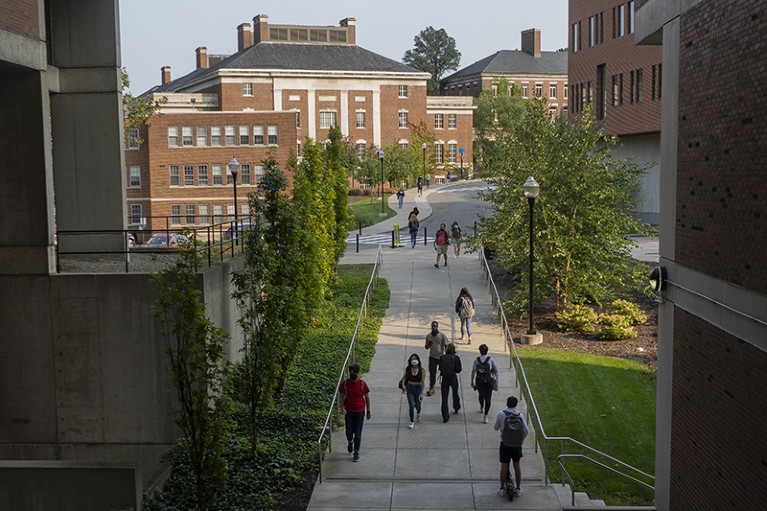
Students on campus at the University of Rochester in New York.Credit: Libby March/Bloomberg via Getty
The second inquiry was prompted by Dirk van der Marel, editor-in-chief of Physica C, a journal for superconductivity research. Van der Marel sent Rochester his own concerns about the same CSH data on 20 January 2022 — just a day after the first inquiry ended. Another reviewer took up the case and judged no formal investigation was warranted on 6 April of that year. Their work was checked by a second reviewer, who appears to be Russell Hemley, a physicist at the University of Illinois Chicago, based on identifying information in the report. Although the reviewers did not support an investigation, they said that the paper was “verging on misleading due to omission of details”. They recommended that an erratum be applied (none was).
Rochester’s investigation notes that two reviewers — apparently Somayazulu and Hemley — have collaborated with Dias on several papers, including a study5 in 2021 about the properties of CSH. Rochester’s academic misconduct policy states that “no individual who has an unresolved personal, professional or financial conflict of interest … should participate in the proceedings” of an inquiry.
A spokesperson for Argonne denied that Somayazulu was an inquiry reviewer, but did not respond when asked why a footnote in the investigation refers to “Report of Somayazulu_Review of NSF 2020 (CSH) Paper”. Hemley did not clarify whether he was an inquiry reviewer.
Nature‘s journals team conducted its own investigation into the CSH paper using independent reviewers, two of whom found evidence that the magnetic susceptibility data were probably fabricated. When the journal indicated that it would retract the CSH paper, and in response to another complaint from Hirsch, the university conducted a third inquiry. Despite having access to Nature’s findings, the single reviewer assigned to this inquiry — the same anonymous reviewer from the second inquiry — concluded on 19 October 2022 that any oddities in the data could be attributed to how they were processed, and that no investigation was needed.
Rochester’s inquiries “should be ‘Exhibit A’ about how not to run one of these things,” says Peter Armitage, a condensed-matter experimentalist at Johns Hopkins University in Baltimore, Maryland.
Under investigation
Rochester was finally forced to launch a full investigation to determine misconduct by the NSF. In October 2022, James Hamlin, a physicist at the University of Florida in Gainesville, submitted concerns about Dias’s work to the NSF. These included “data discrepancies that cannot be attributed to data processing”, according to a 16 March 2023 letter from the NSF to Stephen Dewhurst, the then-interim vice-president for research at Rochester.
Within weeks, Dewhurst assembled a committee of three physicists external to Rochester “to ensure that this investigation would be credible”: Marius Millot and Peter Celliers, both at Lawrence Livermore National Laboratory in California; and Marcus Knudson, at Sandia National Laboratories in Albuquerque, New Mexico.
Nature retracts controversial superconductivity paper by embattled physicist
Nature’s news team asked several superconductivity researchers to review the investigation report. At first, they were concerned by the university’s choice of committee members. The three physicists are specialists in shock-wave physics, not in superconductivity. Millot and Celliers were also co-authors with Dias on a 27-author review paper published earlier this year6.
However, those doubts evaporated when the researchers read the report. “I couldn’t help but be incredibly impressed,” Armitage says. Paul Canfield, a physicist at Iowa State University in Ames, says: “There should be a good German word that’s 50 letters long and is simultaneously ‘impressive’ and ‘depressing’” to describe the report. Brad Ramshaw, a physicist at Cornell University in Ithaca, New York, concurs. “This is a great sacrifice of their time,” he says. “The whole community should be grateful that we have colleagues who are willing to go to these lengths.”
The three investigators did not respond to requests for comment.
The investigation committee secured records, including data on computer hard drives, e-mails and physical notebooks, in the course of their work. They also conducted interviews with 10 individuals connected with the case, including Dias and some of his former students, and met at least 50 times to deliberate.
‘A very disturbing picture’: another retraction imminent for controversial physicist
Notably, the investigators confirmed previous analyses by van der Marel, Hirsch, Hamlin and Ramshaw — all of whom found apparent evidence that Dias fabricated magnetic susceptibility data in the CSH paper.
The report clarifies the extent of this misconduct: first Dias fabricated CSH data and published it. Then, when its origins came under scrutiny, Dias and his collaborator and co-author Ashkan Salamat, a physicist at the University of Nevada, Las Vegas (UNLV), released a set of fabricated raw data.
Questions about discrepancies between the raw and the published data continued to mount, so Dias crafted an explanation — he claimed to have used an elaborate data-processing method for the published data. This provided “a veneer of plausibility, by focusing critics’ attention on background subtraction methods” instead of on the raw data, the investigation committee wrote.
Salamat did not respond to a request for comment.
Fact finding
At any time throughout the investigation, Dias could have dispelled many allegations if he had provided genuine raw data — data taken directly from a measuring instrument and containing details such as timestamps. “The absence of certain raw data files does not inherently indicate their non-existence or suggest any misconduct on my part,” Dias wrote in response to the investigation findings. Yet he promised to deliver raw data multiple times and never did, according to the report.
In several instances, the investigation found, Dias intentionally misled his team members and collaborators about the origins of data. Through interviews, the investigators worked out that Dias had told his partners at UNLV that measurements were taken at Rochester, but had told researchers at Rochester that they were taken at UNLV.
Dias also lied to journals. In the case of the retracted PRL paper4 — which was about the electrical properties of manganese disulfide (MnS2) — the journal conducted its own investigation and concluded that there was apparent fabrication and “a deliberate attempt to obstruct the investigation” by providing reviewers with manipulated data rather than raw data. The investigators commissioned by Rochester confirmed the journal’s findings that Dias had taken electrical resistance data on germanium tetraselenide from his own PhD thesis and passed these data off as coming from MnS2 — a completely different material with different properties (see ‘Odd similarity’). When questioned about this by the investigators, Dias sent them the same manipulated data that was sent to PRL.
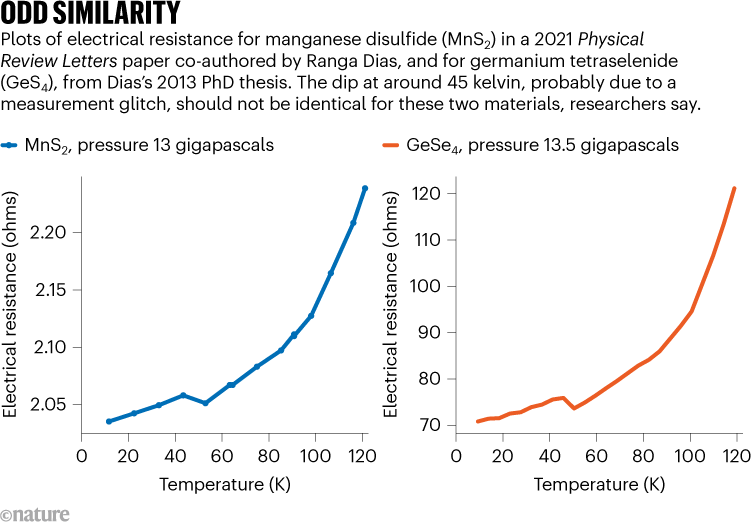
Source: James Hamlin
How exactly Dias distorted data was clearest in the report’s findings about the LuH paper2. With the aid of Dias’s former students, the investigation committee pinpointed raw data on the lab’s hard drives. These data showed that Dias frequently made selective omissions to conceal “erratic drops and jumps in the resistance data, the presence of which would undermine the claim of superconducting behavior in LuH”, the investigation committee wrote.
Dias, the investigation committee found, “repeatedly lied” about data during Nature’s review of the paper after concerns came to light. But perhaps the most egregious instance of misconduct, which the report refers to as involving “profuse manipulations” of data, occurred when Dias inverted a set of LuH data so that it demonstrated the Meissner effect — a sharp change in the magnetic properties of a material that is a hallmark of superconductivity. On 27 August 2022, Sachith Dissanayake, a co-author who was then a faculty member working with Dias at Rochester, explained to Dias that the data had been improperly manipulated, but Dias ignored the warning, according to the report. In his response to the report, Dias claimed Dissanayake misunderstood the data. Dissanayake did not respond to a request for comment.
These manipulated data were key to the LuH paper’s acceptance. And the investigation committee concluded that Dias fabricated data “to convince Nature editors and pre-publication referees that LuH exhibits superconductivity at room temperature”.
Previous stories in Physics Magazine and Science reported allegations of serial plagiarism by Dias, including that he copied more than 20% of his 2013 thesis from other sources. The Rochester investigators uncovered another, more recent instance: on 30 July 2020, researchers, including Dias’s colleagues at Rochester, submitted a scientific manuscript7 to the preprint server arXiv. Twelve days later, Dias submitted an NSF grant proposal that included paragraphs copied from that manuscript, as well as two identical figures. That proposal later won Dias the CAREER grant from the agency. In his response to the investigation, Dias admits to “instances where references are inadvertently missed”.
Closing arguments
The investigation committee sent Dias a draft copy of its report on 22 December last year. In a two-part response totalling hundreds of pages, which was revealed in the lawsuit, Dias attacks the expertise and integrity of the investigators. The physicist asserts that the investigators’ approach displays “traits that could sometimes be seen in the realm of conspiracy theories” and that it is “lacking a robust logical foundation”. Dias also claims that Salamat convinced Dias’s former students to oppose him when they sent a letter to Nature asking to retract the LuH paper. The opposite is true: Nature’s news team previously reported that it was the students who initiated the letter.
Why superconductor research is in a ‘golden age’ — despite controversy
Nowhere in the response does Dias provide the raw data requested by the committee. In their final report, the investigators respond to Dias’s accusations, saying that the “invocation of baroque explanations to interpret, and therefore justify, the omission of these data does not alter the Investigation Committee’s reasoning or findings”.
Ultimately, the committee found that the Rochester students and Dissanayake were not culpable, but victims. The committee did not have access to resources at UNLV to clear those researchers, including Salamat, from blame, but it concluded that those parties too were deceived, and did not find “substantial evidence of wrongdoing”.
As a result, the investigators recommended that Dias should not be permitted to teach or to carry out public or privately funded research. They added: “Evidence uncovered in this investigation shows that [Dias] cannot be trusted”.
Source link

